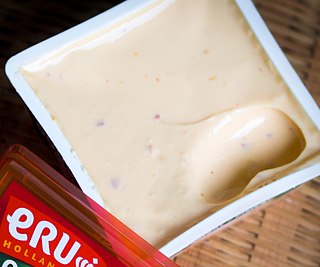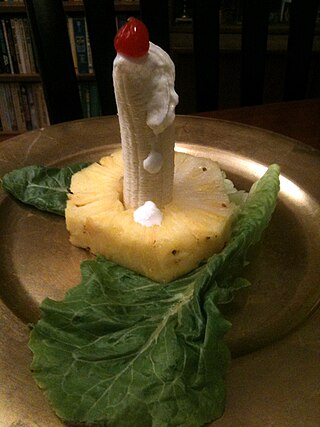
A cheese ball is an American hors d'oeuvre that is a type of cheese spread. It first appeared in the 1940s, fell out of fashion, and then had a resurgence in popularity in the 21st century.

A cheese ball is an American hors d'oeuvre that is a type of cheese spread. It first appeared in the 1940s, fell out of fashion, and then had a resurgence in popularity in the 21st century.

The cheese ball is typically made from grated hard cheese and softened cream cheese, sometimes with some sort of binder such as mayonnaise; the mixture is shaped, chilled to resolidify, and often rolled in nuts, seeds, or herbs to provide a decorative finish. [1] [2] It is often served with crackers or crudites at holiday parties in the United States. [3] [4] [5]
Cheese balls are sometimes formed into wheels or logs rather than balls or shaped and decorated to represent a variety of items such as owls or pineapples. [1] [6] [7]
The dish is representative of mid-20th century US cuisine. [8] According to Splendid Table the first recipe appeared in a 1944 cookbook by Virginia Safford, a "wildly popular columnist" for the Minneapolis Star Journal. [8] [9]
The dish fell out of fashion for a period; by the late 1980s the term "cheeseball" was synonymous with "lacking style, taste, or originality". [10] According to Amanda Hesser, writing for the New York Times in 2003, it "tend[s] to be associated with shag rugs and tinsel, symbols of the middle-class middlebrow". [2] Kim Severson, writing for The New York Times in 2016, said it was "the culinary equivalent of a Rorschach test". [7]
Amy Sedaris and her brother David wrote a play, The Book of Liz, that focussed on cheese balls as a metaphor for "the cliches we all live by", according to Ben Brantley. [7] [11] She included a recipe in her 2006 cookbook, Hosting a Party Under the Influence, and in 2007 made a version on the Martha Stewart Show, which according to Severson, "elevated cheese ball kitsch to an art form". [12] [7] [13] According to Splendid Table's Jennifer Russell, writing in 2014, "Sedaris may be singlehandedly responsible for the cheese ball's revival." [8] In 2014 Culture, an industry magazine, said "cheese balls are making their comeback". [12] MplsStPaul Magazine called 2016 "the year of the cheese ball", calling the dish "the North’s answer to Southern pimento cheese". [7] [9]
Amanda Hesser is an American food writer, editor, cookbook author and entrepreneur. Most notably, she was the food editor of The New York Times Magazine, the editor of T Living, a quarterly publication of The New York Times, author of The Essential New York Times Cookbook which was a New York Times bestseller, and co-founder and CEO of Food52.

Amy Louise Sedaris is an American actress, comedian, and writer. Most recently, she has appeared in both The Mandalorian (2019–2023) and The Book of Boba Fett (2022) as Peli Motto. She played Jerri Blank in the Comedy Central comedy series Strangers with Candy (1999–2000) and the prequel film Strangers with Candy (2005), which she also wrote.

Macaroni and cheese is a dish of macaroni pasta and a cheese sauce, most commonly cheddar sauce.

A soufflé is a baked egg dish originating in France in the early 18th century. Combined with various other ingredients, it can be served as a savoury main dish or sweetened as a dessert. The word soufflé is the past participle of the French verb souffler, which means to blow, breathe, inflate or puff.

Chicago-style pizza is pizza prepared according to several styles developed in Chicago. It can refer to both the well-known deep-dish or stuffed pizzas and the lesser-known thin-crust "tavern-style" pizzas. The pan in which deep-dish pizza is baked gives the pizza its characteristically high edge, which provides ample space for large amounts of cheese and a chunky tomato sauce. Chicago-style deep-dish pizza may be prepared either this way or stuffed. Chicago-style thin-crust pizza dough is rolled for a thinner, crispier crust than other thin-crust styles, and the pizza is cut in squares instead of slices.

Deviled eggs, also known as stuffed eggs, curried eggs or dressed eggs, are hard-boiled eggs that have been peeled, cut in half, with the yolk scooped out and then refilled having been mixed with other ingredients such as mayonnaise, mustard and sprinkled with paprika, cinnamon or curry powder. They are generally served cold as a side dish, appetizer or a main course during gatherings or parties. The dish is popular in Europe, North America and Australia.

Ruth Reichl is an American chef, food writer and editor. In addition to two decades as a food critic, mainly spent at the Los Angeles Times and The New York Times, Reichl has also written cookbooks, memoirs and a novel, and has been co-producer of PBS's Gourmet's Diary of a Foodie, culinary editor for the Modern Library, host of PBS's Gourmet's Adventures With Ruth, and editor-in-chief of Gourmet magazine. She has won six James Beard Foundation Awards.

Kofta is a family of meatball or meatloaf dishes found in South Asian, Central Asian, Balkan, Middle Eastern, North African, and South Caucasian cuisines. In the simplest form, koftas consist of balls of minced meat—usually beef, chicken, pork, lamb or mutton, or a mixture—mixed with spices and sometimes other ingredients. The earliest known recipes are found in early Arab cookbooks and call for ground lamb.

Cheese spread is a soft spreadable cheese or processed cheese product. Various additional ingredients are sometimes used, such as multiple cheeses, fruits, vegetables and meats, and many types of cheese spreads exist. Pasteurized process cheese spread is a type of cheese spread prepared using pasteurized processed cheese and other ingredients.

Mì Quảng, literally "Quảng noodles", is a Vietnamese noodle dish that originated in Quảng Nam Province in central Vietnam. It is one of the region's most popular and well-recognized food items, and is served on various occasions, such as at family parties, death anniversaries, and Tết. It is a common food item in Ðà Nẵng and the surrounding regions, where it is eaten at any time of day.

Pimento cheese is a spread typically made of cheese, mayonnaise, and pimentos and is typically served on crackers and vegetables or in sandwiches.

A Dutch baby pancake, sometimes called a German pancake, a Bismarck, a Dutch puff, Hooligan, or a Hootenanny, is a dish that is similar to a large Yorkshire pudding.

Spinach salad is a salad with spinach as its main ingredient. In the US, a version dressed in a hot bacon dressing which slightly wilts the spinach was popular in the 1970s and into the 1980s and has been called the classic version.

A Bacon Explosion is a pork dish that consists of bacon wrapped around a filling of spiced sausage and crumbled bacon. The American-football-sized dish is then smoked or baked. It became known after being posted on the BBQ Addicts blog, and spread to the mainstream press with numerous stories discussing the dish. In time, the articles began to discuss the Internet "buzz" itself.

Candle salad is a vintage fruit salad that was popular in America from the 1920s through to the 1960s. The salad is typically composed of lettuce, pineapple, banana, cherry, and either mayonnaise or, according to some recipes, cottage cheese. Whipped cream may also be used. The ingredients are assembled to resemble a lit candle.
Denise Landis is a British-born American food writer, editor, cookbook author, and recipe tester and developer. She was a recipe tester for The New York Times for over twenty-five years. She is the founder and CEO of the international food community for professional chefs and passionate home cooks, The Cook's Cook, LLC, with a website and free community registration at TheCooksCook.com.

Gondi (go-n-dee), sometimes spelled as ghondi, or gundi, is a Persian Jewish dish of meatballs made from ground lamb, veal or chicken traditionally served on Shabbat. Dried lime is sometimes used as an ingredient. Gondi are served as part of chicken soup served on Shabbat and other Jewish holidays, similar to their Ashkenazi Jewish counterpart matzo balls.

Vegetable Kingdom: The Abundant World of Vegan Recipes, often shortened to Vegetable Kingdom, is a 2020 cookbook by Bryant Terry. It received positive reviews and won an NAACP Image Award. Recipes are based on the cuisines of the African diaspora. The book provides a song pairing for each dish.
The Essential New York Times Cookbook is a cookbook published by W. W. Norton & Company and authored by former The New York Times food editor Amanda Hesser. The book was originally published in October 2010 and contains over 1,400 recipes from the past 150 years in The New York Times, all of which were tested by Hesser and her assistant, Merrill Stubbs, prior to the book's publication. The book has recipes dating from the mid 1850s, when The New York Times first began publishing topics about food and recipes.
Food52 is a recipe and cookware website. Founded in 2009 by Amanda Hesser and Merrill Stubbs, formerly of the New York Times, its website is intended as a platform for users to publish recipes and discuss cooking. The company also produces its own books.